 Technology peripherals
Technology peripherals
 AI
AI
 The 8B text multi-modal large model index is close to GPT4V. Byte, Huashan and Huake jointly proposed TextSquare
The 8B text multi-modal large model index is close to GPT4V. Byte, Huashan and Huake jointly proposed TextSquare
The 8B text multi-modal large model index is close to GPT4V. Byte, Huashan and Huake jointly proposed TextSquare

The AIxiv column is a column where this site publishes academic and technical content. In the past few years, the AIxiv column of this site has received more than 2,000 reports, covering top laboratories from major universities and companies around the world, effectively promoting academic exchanges and dissemination. If you have excellent work that you want to share, please submit an article or contact the reporting email. Submission email: liyazhou@jiqizhixin.com; zhaoyunfeng@jiqizhixin.com.
Recently, multimodal large models (MLLM) have made significant progress in the field of text-centric VQA, especially multiple closed-source models, such as: GPT4V and Gemini , and even demonstrated performance beyond human capabilities in some aspects. However, the performance of open source models is still far behind closed source models. Recently, many groundbreaking studies, such as: MonKey, LLaVAR, TG-Doc, ShareGPT4V, etc., have begun to focus on the problem of insufficient instruction fine-tuning data. Although these efforts have achieved remarkable results, there are still some problems. Image description data and VQA data belong to different domains, and there are inconsistencies in the granularity and scope of image content presentation. Furthermore, the relatively small size of synthetic data prevents MLLM from realizing its full potential.

Paper title: TextSquare: Scaling up Text-Centric Visual Instruction Tuning
Paper address: https ://arxiv.org/abs/2404.12803
To reduce this
VQA data generation
Square strategy approach It includes four steps: Self-Questioning, Self-Answering, Reasoning, and Self-Evaluation. Self-Questioning leverages MLLM's capabilities in text-image analysis and understanding to generate questions related to the text content in the image. Self-Answering provides answers to these questions using various prompting techniques such as: CoT and few-shot. Self-Reasoning uses the powerful reasoning capabilities of MLLMs to generate the reasoning process behind the model. Self-Evaluation improves data quality and reduces bias by evaluating questions for validity, relevance to image text content, and answer accuracy.
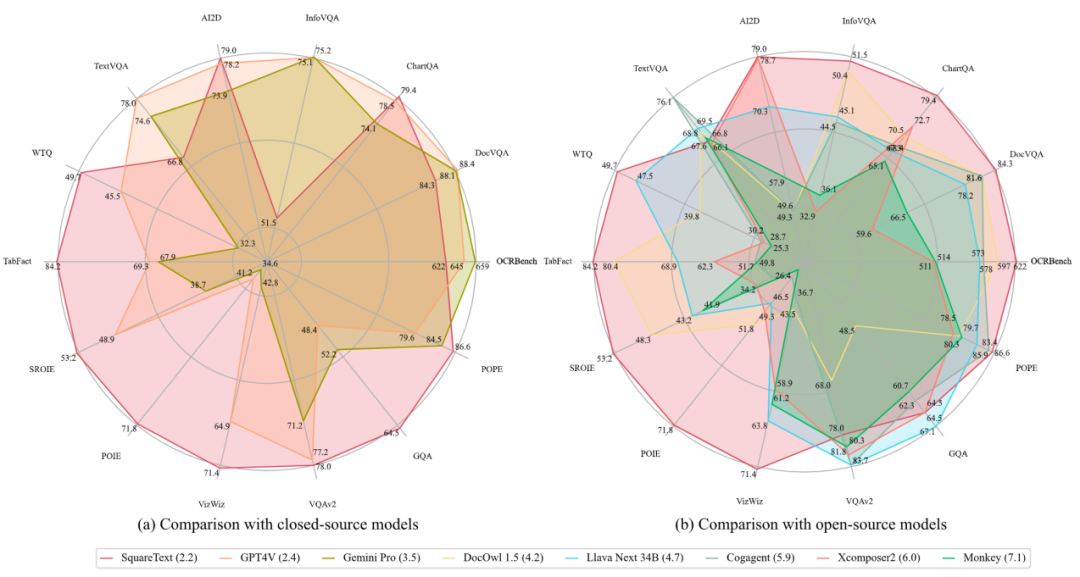
Based on the Square method, the researchers collected a diverse set of images containing a large amount of text from various public sources, including natural scenes, charts, forms, Square-10M was built using receipts, books, PPT, PDF, etc., and TextSquare-8B, an MLLM centered on text understanding, was trained based on this data set.
As shown in Figure 1, TextSquare-8B can achieve results comparable to or better than GPT4V and Gemini on multiple benchmarks, and significantly exceeds other open source models. TextSquare experiments verified the positive impact of inference data on the VQA task, demonstrating its ability to improve model performance while reducing hallucinations.
In addition, by utilizing large-scale data sets, the relationship between instruction adjustment data size, training convergence loss, and model performance is revealed. Although a small amount of instruction adjustment data can train MLLM well, as the instruction adjustment data continues to expand, the performance of the model can be further increased, and there is also a corresponding scaling law between the instruction fine-tuning data and the model.
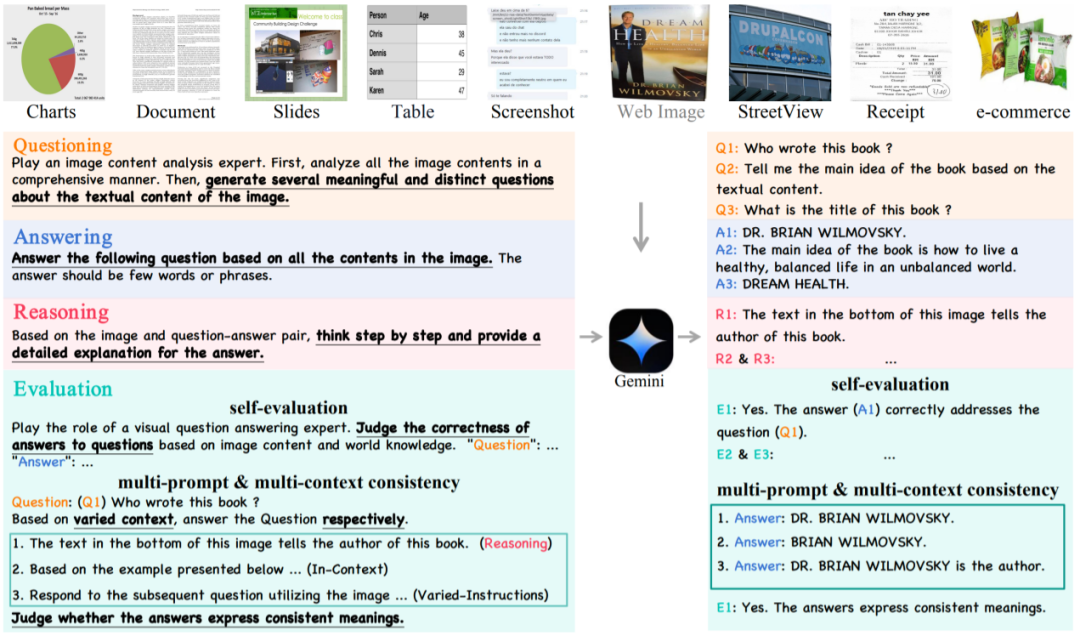

## 图 3 Square-10M image distribution and QA distribution and other details data collection
The main goal of the data collection strategy is to cover a wide range of real-world text-rich scenarios. To this end, the researchers collected 3.8 million text-rich images. These images exhibit different characteristics, for example, charts and tables focus on textual elements with dense statistical information; PPT, screenshots, and WebImages are designed for interaction between text and highlighted visual information; Documents/PDFs, receipts, and E-commerce contains images with detailed and dense text; street views are derived from natural scenes. The collected images form a mapping of textual elements in the real world and form the basis for studying text-centric VQA.
Data generation
Researchers use Gemini Pro's multi-modal understanding capabilities to select images from specific data sources and go through three stages of self-questioning, self-answering, and self-reasoning Generate VQA and inference context pairs.
Self-Question: At this stage, some prompts will be given. Gemini Pro will conduct a comprehensive analysis of the image based on these prompts and generate some meaningful information based on the understanding. The problem. Considering that general MLLM's ability to understand text elements is usually weaker than that of visual models, we preprocess the extracted text into prompt through a specialized OCR model.
Self-Answering: Gemini Pro will use technologies such as chain of thought (CoT) and few-shot prompting to enrich contextual information when generating questions. Improve the reliability of generated answers.
Self-Reasoning: This stage will generate detailed reasons for the answer, forcing Gemini Pro to think more about the connection between the problem and the visual elements, thereby reducing illusions and improve accurate answers.
Data filtering
Although self-questioning, answering, and reasoning are valid, the generated image-text pairs may face illusory content, no Meaning questions and wrong answers. Therefore, we design filtering rules based on LLM's evaluation capabilities to select high-quality VQA pairs.
Self-Evaluation Tips Gemini Pro and other MLLMs determine whether the generated questions make sense and whether the answers are sufficient to correctly solve the problem.
Multi-Prompt Consistency In addition to directly evaluating the generated content, researchers also manually add prompts and context space in data generation. A correct and meaningful VQA pair should be semantically consistent when different prompts are provided.
Multi-Context Consistency The researcher further verified the VQA pair by preparing different context information before the question.
TextSquare-8B
TextSquare-8B draws on the model structure of InternLM-Xcomposer2, including the vision of CLIP ViT-L-14-336 Encoder, the image resolution is further increased to 700; a large language model LLM based on InternLM2-7B-ChatSFT; a bridge projector that aligns visual and text tokens.
TextSquare-8B’s training includes three stages of SFT:
The first stage fine-tunes the model with full parameters (Vision Encoder, Projector, LLM) at a resolution of 490.
In the second stage, the input resolution is increased to 700 and only the Vision Encoder is trained to adapt to the resolution change.
In the third stage, all parameters are further fine-tuned at a resolution of 700.
TextSquare confirms that based on the Square-10M dataset, a model with 8B parameters and normal-sized image resolution can achieve better than most MLLMs, even closed ones, on text-centric VQA. Effects of source models (GPT4V, Gemini Pro).
Experimental results
Figure 4(a) shows that TextSquare has simple arithmetic functions. Figure 4(b) shows the ability to understand text content and provide an approximate location in dense text. Figure 4(c) shows TextSquare’s ability to understand table structures.
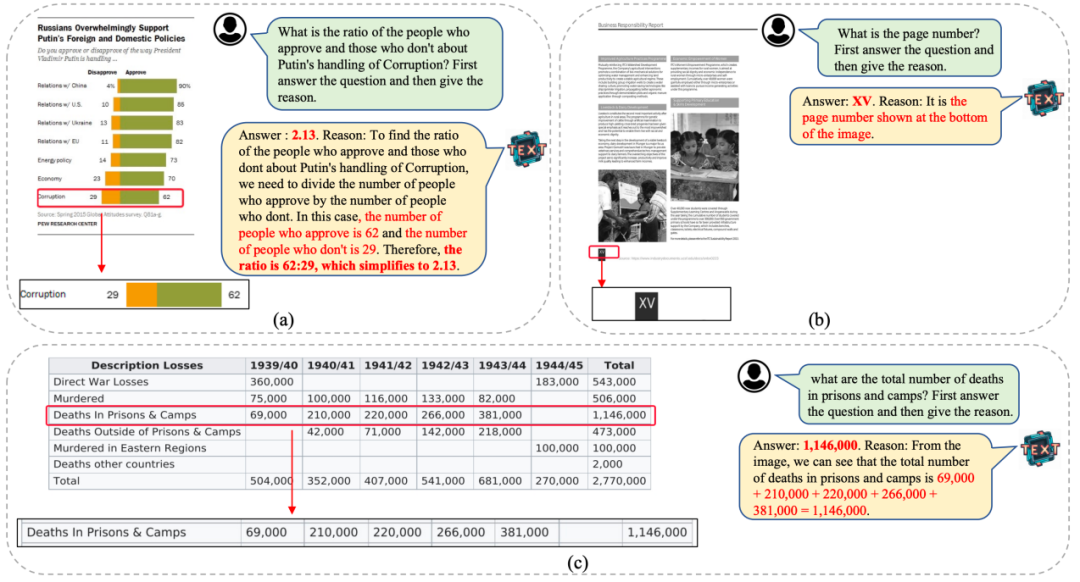
MLLM Benchmark

##Document-Oriented Benchmark has an average improvement of 3.5% on the VQA Benckmark (DocVQA, ChartQA, InfographicVQA) of the document scene, which is better than all open source models, and is slightly higher than GPT4V and Gemini Pro on the ChartQA data set. The resolution of this model is only 700, smaller than For most document-oriented MLLM, if the resolution is further improved, I believe the model performance will also be further improved, and Monkey has proven this.
Scene Text-centric Benchmark The SOTA effect has been achieved in the VQA Benchmark (TextVQA, AI2D) of natural scenes, but there is no major improvement compared with baseline Xcomposer2 , probably because Xcomposer2 has been fully optimized using high-quality in-domain data.
Table VQA Benchmark In the VQA Benchmark (WTQ, TabFact) of the table scenario, the results far exceed those of GPT4V and Gemini Pro, respectively exceeding other SOTA models by 3% .
Text-centric KIE Benchmark Extract the key information of the text center from the benchmark of the KIE task (SROIE, POIE), and convert the KIE task into a VQA task. In both data sets, The best performance was achieved, with an average improvement of 14.8%.
OCRBench Includes 29 OCR-related evaluation tasks such as text recognition, formula recognition, text-centered VQA, KIE, etc., achieving the best performance of the open source model, and Becoming the first model with a parameter volume of about 10B reaching 600 points.
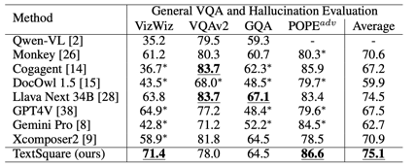
##General VQA and Hallucination Evaluation Benchmark In general VQA Benchmark (VizWiz VQAv2, GQA, TextSquare on POPE) has no significant degradation compared to Xconposer2 and still maintains the best performance. It shows significant performance on VisWiz and POPE, 3.6% higher than the best methods, which highlights the effectiveness of this method. sex, can reduce model hallucination.
Ablation experiment

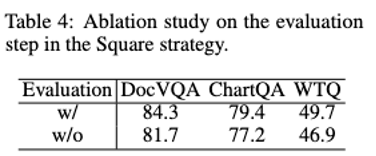

Data scale and convergence loss & model performance relationship
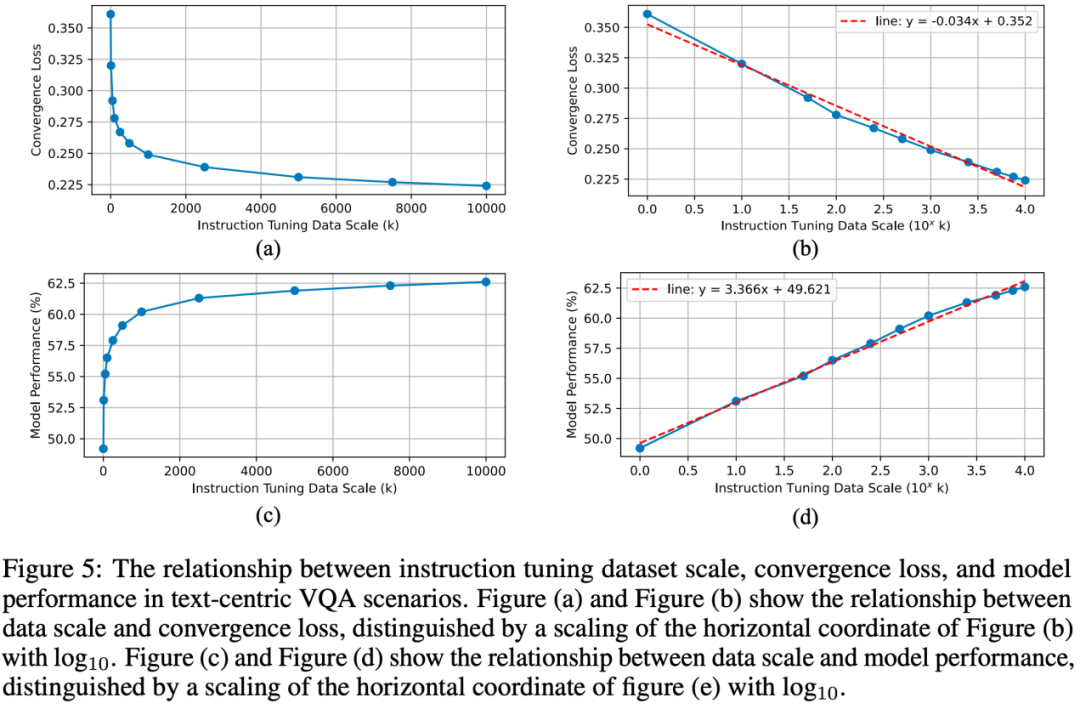
Summary
In this paper, the researchers proposed a Square strategy to build a high-quality text-centric instruction tuning data set (Square-10M). Using this dataset, TextSquare-8B achieves performance comparable to GPT4V on multiple benchmarks, and significantly outperforms recently released open source models on various benchmarks. In addition, the researchers derived the relationship between instruction adjustment data set size, convergence loss and model performance to pave the way for building larger data sets, confirming that the quantity and quality of data have an important impact on model performance. Crucial. Finally, the researchers pointed out that how to further improve the quantity and quality of data to narrow the gap between open source models and leading models is considered a highly promising research direction.The above is the detailed content of The 8B text multi-modal large model index is close to GPT4V. Byte, Huashan and Huake jointly proposed TextSquare. For more information, please follow other related articles on the PHP Chinese website!

Hot AI Tools

Undresser.AI Undress
AI-powered app for creating realistic nude photos

AI Clothes Remover
Online AI tool for removing clothes from photos.

Undress AI Tool
Undress images for free

Clothoff.io
AI clothes remover

AI Hentai Generator
Generate AI Hentai for free.

Hot Article

Hot Tools

Notepad++7.3.1
Easy-to-use and free code editor

SublimeText3 Chinese version
Chinese version, very easy to use

Zend Studio 13.0.1
Powerful PHP integrated development environment

Dreamweaver CS6
Visual web development tools

SublimeText3 Mac version
God-level code editing software (SublimeText3)

Hot Topics
 From RLHF to DPO to TDPO, large model alignment algorithms are already 'token-level'
Jun 24, 2024 pm 03:04 PM
From RLHF to DPO to TDPO, large model alignment algorithms are already 'token-level'
Jun 24, 2024 pm 03:04 PM
The AIxiv column is a column where this site publishes academic and technical content. In the past few years, the AIxiv column of this site has received more than 2,000 reports, covering top laboratories from major universities and companies around the world, effectively promoting academic exchanges and dissemination. If you have excellent work that you want to share, please feel free to contribute or contact us for reporting. Submission email: liyazhou@jiqizhixin.com; zhaoyunfeng@jiqizhixin.com In the development process of artificial intelligence, the control and guidance of large language models (LLM) has always been one of the core challenges, aiming to ensure that these models are both powerful and safe serve human society. Early efforts focused on reinforcement learning methods through human feedback (RL
 The author of ControlNet has another hit! The whole process of generating a painting from a picture, earning 1.4k stars in two days
Jul 17, 2024 am 01:56 AM
The author of ControlNet has another hit! The whole process of generating a painting from a picture, earning 1.4k stars in two days
Jul 17, 2024 am 01:56 AM
It is also a Tusheng video, but PaintsUndo has taken a different route. ControlNet author LvminZhang started to live again! This time I aim at the field of painting. The new project PaintsUndo has received 1.4kstar (still rising crazily) not long after it was launched. Project address: https://github.com/lllyasviel/Paints-UNDO Through this project, the user inputs a static image, and PaintsUndo can automatically help you generate a video of the entire painting process, from line draft to finished product. follow. During the drawing process, the line changes are amazing. The final video result is very similar to the original image: Let’s take a look at a complete drawing.
 Topping the list of open source AI software engineers, UIUC's agent-less solution easily solves SWE-bench real programming problems
Jul 17, 2024 pm 10:02 PM
Topping the list of open source AI software engineers, UIUC's agent-less solution easily solves SWE-bench real programming problems
Jul 17, 2024 pm 10:02 PM
The AIxiv column is a column where this site publishes academic and technical content. In the past few years, the AIxiv column of this site has received more than 2,000 reports, covering top laboratories from major universities and companies around the world, effectively promoting academic exchanges and dissemination. If you have excellent work that you want to share, please feel free to contribute or contact us for reporting. Submission email: liyazhou@jiqizhixin.com; zhaoyunfeng@jiqizhixin.com The authors of this paper are all from the team of teacher Zhang Lingming at the University of Illinois at Urbana-Champaign (UIUC), including: Steven Code repair; Deng Yinlin, fourth-year doctoral student, researcher
 Posthumous work of the OpenAI Super Alignment Team: Two large models play a game, and the output becomes more understandable
Jul 19, 2024 am 01:29 AM
Posthumous work of the OpenAI Super Alignment Team: Two large models play a game, and the output becomes more understandable
Jul 19, 2024 am 01:29 AM
If the answer given by the AI model is incomprehensible at all, would you dare to use it? As machine learning systems are used in more important areas, it becomes increasingly important to demonstrate why we can trust their output, and when not to trust them. One possible way to gain trust in the output of a complex system is to require the system to produce an interpretation of its output that is readable to a human or another trusted system, that is, fully understandable to the point that any possible errors can be found. For example, to build trust in the judicial system, we require courts to provide clear and readable written opinions that explain and support their decisions. For large language models, we can also adopt a similar approach. However, when taking this approach, ensure that the language model generates
 A significant breakthrough in the Riemann Hypothesis! Tao Zhexuan strongly recommends new papers from MIT and Oxford, and the 37-year-old Fields Medal winner participated
Aug 05, 2024 pm 03:32 PM
A significant breakthrough in the Riemann Hypothesis! Tao Zhexuan strongly recommends new papers from MIT and Oxford, and the 37-year-old Fields Medal winner participated
Aug 05, 2024 pm 03:32 PM
Recently, the Riemann Hypothesis, known as one of the seven major problems of the millennium, has achieved a new breakthrough. The Riemann Hypothesis is a very important unsolved problem in mathematics, related to the precise properties of the distribution of prime numbers (primes are those numbers that are only divisible by 1 and themselves, and they play a fundamental role in number theory). In today's mathematical literature, there are more than a thousand mathematical propositions based on the establishment of the Riemann Hypothesis (or its generalized form). In other words, once the Riemann Hypothesis and its generalized form are proven, these more than a thousand propositions will be established as theorems, which will have a profound impact on the field of mathematics; and if the Riemann Hypothesis is proven wrong, then among these propositions part of it will also lose its effectiveness. New breakthrough comes from MIT mathematics professor Larry Guth and Oxford University
 arXiv papers can be posted as 'barrage', Stanford alphaXiv discussion platform is online, LeCun likes it
Aug 01, 2024 pm 05:18 PM
arXiv papers can be posted as 'barrage', Stanford alphaXiv discussion platform is online, LeCun likes it
Aug 01, 2024 pm 05:18 PM
cheers! What is it like when a paper discussion is down to words? Recently, students at Stanford University created alphaXiv, an open discussion forum for arXiv papers that allows questions and comments to be posted directly on any arXiv paper. Website link: https://alphaxiv.org/ In fact, there is no need to visit this website specifically. Just change arXiv in any URL to alphaXiv to directly open the corresponding paper on the alphaXiv forum: you can accurately locate the paragraphs in the paper, Sentence: In the discussion area on the right, users can post questions to ask the author about the ideas and details of the paper. For example, they can also comment on the content of the paper, such as: "Given to
 Unlimited video generation, planning and decision-making, diffusion forced integration of next token prediction and full sequence diffusion
Jul 23, 2024 pm 02:05 PM
Unlimited video generation, planning and decision-making, diffusion forced integration of next token prediction and full sequence diffusion
Jul 23, 2024 pm 02:05 PM
Currently, autoregressive large-scale language models using the next token prediction paradigm have become popular all over the world. At the same time, a large number of synthetic images and videos on the Internet have already shown us the power of diffusion models. Recently, a research team at MITCSAIL (one of whom is Chen Boyuan, a PhD student at MIT) successfully integrated the powerful capabilities of the full sequence diffusion model and the next token model, and proposed a training and sampling paradigm: Diffusion Forcing (DF). Paper title: DiffusionForcing:Next-tokenPredictionMeetsFull-SequenceDiffusion Paper address: https:/
 Axiomatic training allows LLM to learn causal reasoning: the 67 million parameter model is comparable to the trillion parameter level GPT-4
Jul 17, 2024 am 10:14 AM
Axiomatic training allows LLM to learn causal reasoning: the 67 million parameter model is comparable to the trillion parameter level GPT-4
Jul 17, 2024 am 10:14 AM
Show the causal chain to LLM and it learns the axioms. AI is already helping mathematicians and scientists conduct research. For example, the famous mathematician Terence Tao has repeatedly shared his research and exploration experience with the help of AI tools such as GPT. For AI to compete in these fields, strong and reliable causal reasoning capabilities are essential. The research to be introduced in this article found that a Transformer model trained on the demonstration of the causal transitivity axiom on small graphs can generalize to the transitive axiom on large graphs. In other words, if the Transformer learns to perform simple causal reasoning, it may be used for more complex causal reasoning. The axiomatic training framework proposed by the team is a new paradigm for learning causal reasoning based on passive data, with only demonstrations





